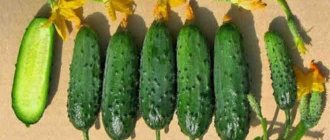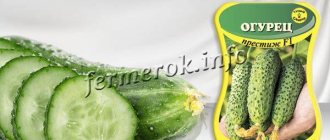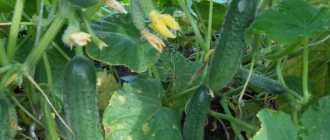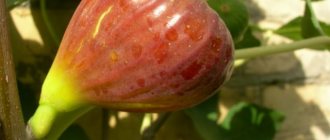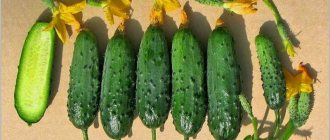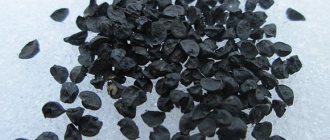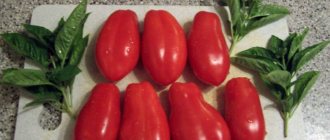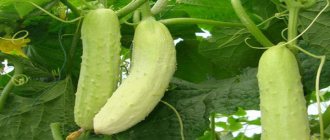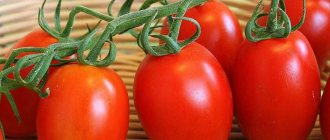Cucumbers are a symbol of the end of the vitamin deficiency season. The first greens from local gardens appear on markets in the second half of May.
From a huge number of varieties and hybrids, many choose a proven cucumber with the self-explanatory name Competitor. This variety has been present on the domestic market for more than 40 years. During this time, it not only has not lost its popularity, but also successfully competes with more modern breeding achievements. What is the secret of the Competitor’s success? Read on.
Description of cucumbers Competitor
Having studied in more detail the characteristics and description of the Competitor cucumber variety, we can come to the conclusion that this crop is very profitable to plant in a summer cottage.
Competitor - a variety convenient for planting in a summer cottage or greenhouse. This culture has heterosexual flowers and a single ovary. Inflorescences require pollination by bees. The length of the bush can reach 2 m.
Important! To get a good harvest, it is important to carry out the procedure for forming a bush.
Description of fruits
The fruits of the cucumber variety Competitor are rich green, cylindrical in shape with small tubercles and white stripes. The length of one cucumber can reach 12 cm. The flesh of the plant is dense, the fruits are crunchy.
Farmer reviews
- Nadezhda, 54 years old, Voronezh
I decided to grow Competitor cucumbers at my summer cottage. I'm happy with my choice. The seeds took root well, sprouted well, and the fruits were actively formed. The harvest was enough for our entire large family and for home preparations for the winter.
- Fedor, 65 years old, Bryansk
My children and grandchildren love cucumbers very much, so every year I grow them in large quantities so that I have enough to eat and make homemade preparations for the winter. I have long identified the best variety of cucumbers, Competitor, which is suitable both for taste and the requirements for soil, climate and care. The harvest surprises me with its quantity.
The Competitor variety has proven itself well and is valued for its compact size, friendly yield and excellent taste. Vegetables grown in your garden will be a tasty ingredient for many culinary masterpieces.
Video review of the variety:
Characteristics of cucumbers Competitor
The cucumber tops of the Competitor variety are powerful and weakly branched. The main stem is long – from 1.5 to 2 m, the stalk – up to 6 cm.
Productivity and fruiting
This variety is called “Competitor” due to the fact that it has practically no competitors in the quantity and quality of the harvest. During the fruiting period, up to 5-6 kg of fruit can be collected from 1 m2. But only with regular watering and proper care. The fruiting period lasts from June to the end of August. The culture matures in 5-6 weeks. It is recommended to collect fruits every 2-3 days. Thus, new ovaries will form.
Cucumber of the Competitor variety during the fruiting period in the photo:
Application area
This variety is delicious to eat fresh, but most gardeners use it for canning. The Competitor cucumber is pickled, salted, and winter salads are prepared from it.
This variety is also used for preparing lightly salted cucumbers. This dish will be an excellent addition to any side dish.
Resistance to diseases and pests
The culture is well resistant to diseases:
- bacteriosis;
- powdery and downy mildew;
- olive spot.
The competitor cucumber has good keeping quality; the fruits can be stored for a long time without turning yellow.
Important! By providing Competitor cucumbers with proper care, you can reduce the risk of contracting many diseases.
Advantages and disadvantages of the variety
Based on the characteristics of the Konkurent variety cucumber, it can be noted that this crop has a number of advantages:
- high germination of seed;
- 100% survival rate of seedlings;
- resistance to bacteriosis, downy and powdery mildew;
- long fruiting period;
- possibility of self-harvesting seeds.
The disadvantages of the plant depend on how high-quality care the crop receives during the fruiting period.
It is also worth considering some of the disadvantages that may arise if the harvest is not harvested on time:
- loss of aroma;
- the appearance of cracks on the fruits;
- thick peel;
- the fruits spoil quickly.
Attention! If you do not provide sufficient watering to the cucumbers, the fruits will become bitter.
Video
You can get acquainted with the experience of growing cucumbers on a trellis in open ground by watching the following video:
For several years she worked as a television program editor with leading producers of ornamental plants in Ukraine. At the dacha, of all types of agricultural work, she prefers harvesting, but for this she is ready to regularly weed, pull, shed, water, tie, thin out, etc. I am convinced that the most delicious vegetables and fruits are those grown with your own hands!
Planting and caring for cucumbers Competitor
By planting cucumbers of the Competitor variety according to agrotechnical methods, you can get a decent harvest, and what’s more, you can harvest it all summer long. The best time for planting seed is considered to be mid-May to early June. If planting is planned in the southern regions, you can sow the seeds of Competitor cucumbers in April.
Planting seedlings
According to reviews from summer residents, Competitor cucumber seeds are planted as seedlings 1 month before the expected planting date in an open bed or greenhouse.
Algorithm for sowing seedlings:
- Plant the seeds in small containers 10 by 10 cm and cover with cling film.
- Place the boxes in a warm place (up to 28 degrees) and keep them until the entrances appear.
- After pecking the seeds, remove the film and water.
- During the growth process, make sure that the seedlings do not touch each other.
- Maintain the growing temperature: during the day – 20-23 degrees, at night – 17-20 degrees.
- During the period of sprout growth, fertilize with organic fertilizers (Agricola Forward, Agricola Vegeta, Kemira-Lux).
Advice! When purchasing fertilizers in specialized stores, you should pay attention to the expiration date.
After 30 days, you can prepare the seedlings for planting in the ground or greenhouse. Planting should be done in fertilized soil. For this you can use wood ash and superphosphate.
It is recommended to plant sprouts in a checkerboard pattern, at a distance of 60 cm.
To understand how to properly place Competitor cucumber seedlings in an open garden bed, you can look at the photo:
Growing cucumbers using the seedless method
Before you start planting cucumbers using the seedless method, you should prepare the seeds:
- Last year's harvested material can be sown dry without soaking.
- If the seeds have been stored for more than a year, it is recommended to soak them in a salt solution for 20 minutes.
- Then disinfect in potassium permanganate.
- After soaking, you can plant the seed.
Soil preparation
To get a good harvest of cucumber Competitor, it is better to sow the seeds at the end of May. Grains should be planted in previously prepared soil. The soil must be at a temperature of at least 15 degrees, saturated with humus and similar fertilizers.
Important! To fertilize the soil, you can use any manure: rabbit, pig, sheep, horse.
Planting scheme
Cucumber of the Competitor variety is grown on special trellises. For this, an agrotechnical planting method is used:
- The seed is planted in 2 rows. The distance between rows is at least 25 cm.
- I moisten the soil well.
- They bury trellises next to them at a distance of 80-100 cm.
Selection of terrain for landing
To regularly get a good harvest, you should plant varietal cucumbers in new places. Some of the best predecessors for cucumbers are tomatoes, onions and potatoes. Experienced summer residents do not recommend planting crops in places where carrots and beans grew.
For proper planting in a new location, you should prepare the bed in the fall. The soil is fertilized with mineral or organic fertilizers, and the area is dug up closer to spring.
Aftercare for cucumbers
The Competitor variety cucumber is absolutely unpretentious in cultivation and care. Well resistant to fungi and other diseases. The basic rules for caring for crops are:
- regular watering;
- removal of weeds;
- feeding with fertilizers;
- loosening the soil.
Bush formation
During the formation of the bush, a number of procedures are performed:
- Blinding procedure on the first 4-leaf axil of the main loop. The ovaries and stepsons are removed. Thus, the plant forms a strong root and is well overgrown with greenery.
- Leave only 1 ovary at node 5-6.
- At the 7-8th node, leave all the shoots and ovaries, pinch them near the first leaf.
- In the uppermost places, pinch the branches after the second leaf.
- When the crop reaches the trellis, wrap the main stem around it several times, lower it down 60 cm, pinching it.
Attention! By correctly forming the bush, you can ensure good development of the crop.
Sowing seeds
This variety is designed for seedling and non-seedling cultivation. In the southern part of the country, seeds are sown in open ground; in cool regions, seedlings are first grown and transplanted into the garden.
Seed preparation
If you plan to plant your own seeds, know that the best germination is achieved in the 2nd or 3rd year. Accordingly, if you store the seeds in a cool place without high humidity. It is permissible to use the Competitor's seed material for 6 years.
How to prepare the grains:
- sort - to do this, immerse in salted water for 10-15 minutes, and remove the floating elements;
- wash the seeds;
- disinfect - make a weak solution of manganese, immerse the seeds in it for 24 hours;
- soak the seeds in water;
- transfer to wet gauze;
- let it germinate.
Landing dates
When using the seedling method of growing Competitor cucumbers, the planting date is calculated. For this purpose, the date of diving into open ground is determined. From there you need to count back about a month. For example, transplantation to a permanent place is planned for May 1. This means that the seeds are planted on April 1-5.
When planting without seedlings, temperature requirements are met: the soil and air must have a temperature of at least 15-16 degrees. If urgent disembarkation is required, then use this expert advice:
- prepare the soil;
- cover the area with black film;
- let sit for at least 4 days.
Selecting a location
It is recommended to plant cucumbers in a new place every year. The best plot for the Competitor is considered to be the land on which tomatoes, onions, cabbage, and potatoes grew last year. Do not plant after legumes and carrots.
Soil preparation
The competitor is considered an unpretentious plant, but to increase productivity it is necessary to prepare the soil. Approximately 30 days before planting activities, disinfection is carried out. To do this, the earth is filled with a weak solution of manganese or scalded with boiling water. After 2 weeks, the soil is dug up with simultaneous application of fertilizers. To do this, you need to make a solution (the dosage is indicated per 2 square meters):
- 20 liters of compost or slurry;
- 60 grams of urea;
- 30 grams of potassium chloride;
- 60 grams of superphosphate;
- 40 grams of potassium sulfate.
Mix the ingredients thoroughly and water the area.
Sowing schemes
Since the Competitor’s stems grow rapidly, it is advisable to grow the variety on trellises. To do this, 2 rows of seeds are sown (seedlings are planted) with a distance of 20-40 cm, and wooden pegs are driven between them every meter. Wire is attached to them or slats are mounted.
Features of planting seedlings
The Competitor's root system is not particularly powerful, so it is advisable to plant sprouted seeds in peat pots or briquettes. In this case, the root will not be damaged when picking. 2 seeds are placed in each pot.
Features of planting in open ground
When planting in a garden, it is advisable to follow a 40x40 cm pattern, but with the trellis method, a 20x40 cm pattern is suitable. Planting is carried out after disinfecting the soil and applying complex fertilizer. That is, after preparing the soil.
Features of cultivation
Growing conditions
The above variety can produce good yields under certain conditions:
- The variety is capable of producing significant yields in a greenhouse and an ordinary summer cottage.
- The best development of cucumber plants occurs at an ambient temperature of + 23 to + 25 degrees.
- It is very important that the cucumber vines are evenly illuminated throughout the daylight hours.
- The variety prefers loose, light, breathable soils. Such soils are: chernozems, gray soils, gray forest soils. It is important that the acidity of the soil is neutral.
- The best predecessors for this variety are: early potatoes, onions, spinach, early cabbage, carrots and eggplant. It is not recommended to grow the variety after: cucumber, zucchini, pumpkin, melon and watermelon.
Growing seedlings
The seedling method of growing this variety helps to obtain the highest possible yield and reduce the growing period. Seedlings can be purchased ready-made, or you can grow them yourself using the following growing scheme:
- Seed material is sorted by hand, selecting completed and healthy seeds.
- Seeds selected for further sowing are treated with Vitavax 200 FF, Maxim XL, and 1-2% solution of potassium permanganate. The seed treatment period should not exceed 30 minutes.
- To increase the resistance of seedlings to low temperatures, it is recommended to keep the seeds for two days in the refrigerator at a temperature of +1 +3.
- 10-13 hours before sowing, the seeds must be placed in a solution of Epin Extra (1 ml per 7.5-8 liters of water).
- As a soil mixture, you need to use store-bought mixtures “Microgreenhouse”, “Violet” and “Living Earth”. It is most possible to prepare a soil mixture at home consisting of 2 parts turf soil, 1 part rotted manure and 1 part peat.
- The soil mixture is poured into cups 12 cm wide and 13-14 cm deep and filled with water.
- Seeds are sown in cups to a depth of no more than 1.5 cm and no later than mid-March.
- The planted seeds are covered with film on top and the temperature is set in the range of + 25 +27 degrees.
- When seedlings appear, the air temperature should be reduced to + 18 degrees. In addition, during this period it is necessary to provide the seedlings with lighting.
- Seedlings should be protected from drafts and provided with optimal humidity. For this purpose, it is recommended to place containers of water along the edges of the room.
- In order for the seedlings to develop quickly, it is recommended to water every 1-2 days. In this case, the irrigation water should have a temperature of at least + 20 degrees.
- During the entire growing period, you need to fertilize twice using fertilizers: “Solution” (1 teaspoon per 6-7 liters of water) or “Kemira universal” (1-1.5 teaspoons per 5.5-6 liters). water).
- In order for seedlings to withstand transplantation, they must be hardened by lowering the air temperature to + 14 during the day and to +12 degrees at night.
- Valuable planting material of this variety should have 3-5 dark green leaves, a thick stem and short row spacing.
Transplanting
Cucumber seedlings should be planted in greenhouses with additional heating in mid-March. Seedlings should be planted in ordinary film greenhouses or greenhouses during the first half of May. Seedlings should be planted in the beds in early June, when there is no longer a threat of night frosts. The work of planting seedlings consists of the following stages:
- Using a cord, mark the places where the planting holes will be dug. The size of these holes should be 12-13 cm wide and 15-17 cm deep.
- 10-11 g of superphosphate and 180-200 g of rotted manure are added to the holes.
- After applying fertilizer, you need to water the holes abundantly and carefully plant the seedlings from the cup into the center of the hole. At the same time, the soil around the plant is carefully compacted.
Read also: To 700 engine capacity
Watering plants
Watering cucumber plants throughout the entire growing period is very important. Insufficient watering can lead to ovary drop and reduced yield. Watering plants of this variety is carried out according to the following recommendations:
- Irrigation water must have a temperature of at least + 22 degrees. This is due to the fact that when watering with cold water, various diseases can occur on cucumbers.
- It is advisable to water the soil around the cucumber plants in the morning.
- Before the fruits begin to ripen, cucumbers must be irrigated every 6-7 days with 5-6.5 liters. per 1 sq. m.
- During fruit ripening, plants need to be watered more often, up to 3 times a week. For 1 sq. m. spend 9.5-11 liters. irrigation water.
Weed control
It is important to weed the soil around cucumber plants in time to destroy weeds. After all, weeds develop very quickly and during their growth consume a lot of moisture and nutrients. Weeding should be carried out as soon as the first weed shoots appear on the surface. During this period, weeds are effectively destroyed even when weeding to a shallow depth (1-1.7 cm). It is very important not to damage the stem of cucumbers during weeding. In addition to controlling weeds, weeding promotes a faster supply of oxygen and moisture to the roots of cucumbers.
Tying up whips
The variety produces powerful and long shoots that need to be tied up in a timely manner:
- For gartering, a trellis is constructed, which consists of wooden pegs, which are driven into a row of cucumbers at a distance of 2.2-2.5 m from each other. The height of the pegs should be at least 2-2.2 m. At the top, these pegs are fastened together with a transverse crossbar.
- For direct garter, twine is used, to which the shoots of cucumbers are tied as they grow. The first garter is carried out three weeks after planting the seedlings.
Formation of lashes
The variety needs the formation of shoots, which contributes to their better illumination. This process should be done like this:
- Side shoots are shortened to prevent plant thickening.
- In the axils of the second and third leaves, axillary buds are removed.
- At the third and fourth nodes, side shoots are left, pinching them after the third leaf.
- At the next four nodes, two leaves and two fruits are left.
- Three leaves and three fruits are left at the top of the side shoots.
- There should be no more than 13-15 fruits on one stem. Excess fruits need to be picked.
- The mustaches and shoots that have already bear fruit must be removed. With this formation, you get a cucumber bush in the form of an inverted Christmas tree.
Top dressing
To get strong and well-formed shoots, you need to fertilize in the following sequence:
- After rooting the seedlings, feed the soil around the plants with a solution of crushed nitroammophosphate (13-15 g per 9-11 liters of water). The solution consumption should be 6-7.3 liters. per 1 sq. m.
- Before flowering, cucumber plants are fertilized with complex fertilizer “Solution” in a dosage of 8-12 g per 9-10.5 liters. water. For 1 sq. m. add 4.7-5 liters. prepared solution.
- During the period of mass fruiting, cucumbers are fed with Kemira Super fertilizer at a rate of 13-16 g per 10-11 liters. water. With the solution prepared in this way, the soil is fertilized at a rate of 5-6.5 liters. per 1 sq. m.
- After two weeks, feed the cucumber bushes with an infusion of liquid mullein (1:12) or a solution of chicken manure (1:16). The above solutions are used in a dosage of 3.6-4.3 liters. per 1 sq. m.
- In case of slow growth of side shoots, it is necessary to fertilize the cucumbers with urea (13-15 g per 8-10 liters of water). Solution consumption – 4.4-5.5 l. per 1 sq. m.
- To provide cucumbers with the required amount of microelements, it is necessary to fertilize the variety three times per season with Vympel (11-12 ml per 8-9 liters of water). For 1 sq. m. spend 4.5.3 liters. solution.
- If shoots grow excessively and fruiting is delayed, you need to fertilize the soil with crushed superphosphate in a volume of 12-13 g per 11-12 liters. water. The solution is applied evenly over the soil surface at a rate of 5-5.8 liters. per 1 sq. m.
- To increase the number of flowers, you need to use the drug “Ideal” at a rate of 1 cap per 1.2-1.5 liters. water.
Disease Control
If the cultivation technology is violated, the variety may be affected by downy mildew. This disease spreads quickly and can destroy all cucumber bushes on a plot or in a greenhouse. The spread of the disease is favored by cool weather and high humidity. Diseased cucumber plants can be identified by brown, oval-shaped spots on the leaves. Gradually the spots increase in size. Ultimately, the leaves turn brown, dry out and fall off. Measures to combat the disease:
- Grow seedlings from healthy seeds.
- Adhere to recommended crop rotation and planting patterns.
- Spray cucumber plants twice with a 1% solution of Bordeaux mixture. Plants should be treated immediately after rooting with an interval of 8-10 days.
- A week before planting, seedlings are sprayed with a solution of copper oxychloride (28-32 g per 8-9 liters of water).
- If the disease spreads significantly, the cucumber vines should be sprayed with urea (12-13 g per 8.6-9 liters of water).
Pest Control
The greatest damage to the variety is caused by aphids and spider mites. Aphids are a small-sized pest that can multiply intensively and unite in colonies to be located on the lower part of the cucumber leaf. Such leaves curl into a tube and stop growing. In some cases, aphids are able to develop on all above-ground parts of cucumbers. The greatest peak of aphid distribution is recorded in July and August. Aphids feed on cell sap and are carriers of dangerous diseases. Control measures:
- Destruction of weeds and removal of all anthills from the territory of the site.
- Spraying the shoots with a solution of capsicum (3 g of pepper per 1 liter of water at a temperature of + 60 degrees).
- Spraying the shoots with a solution consisting of 100 g of wood ash, 25 g of liquid soap and 10-11 liters. hot water. The solution is infused for 24 hours.
- Spraying with Karbofos, BI-58 N.
Spider mites are most common on cucumbers grown in greenhouses. The largest number of mites accumulate in the greenhouse when the temperature rises above + 20 degrees. The presence of a pest on cucumber shoots can be determined by the appearance of cobwebs on the leaves. Control measures:
- Spraying cucumber plants with insecticides Bicol, Clipper and Akarin.
- After completion of cultivation, it is necessary to collect and destroy plant residues.
- Disinfection of greenhouses using a sulfur bomb at the rate of 90 g per 1 m3.
Harvesting
It is necessary to harvest cucumbers of this variety as the fruits ripen. To prevent cucumbers from overripening, harvesting should be done regularly every 2-3 days. The collection of ripe cucumbers is carried out according to the following recommendations:
- You need to collect ripe fruits, without rot or damage.
- Harvesting should be carried out in dry weather.
- The collected fruits must be cleaned and sorted by size.
- The most acceptable temperature for storing fresh produce is + 2 + 3 degrees.
